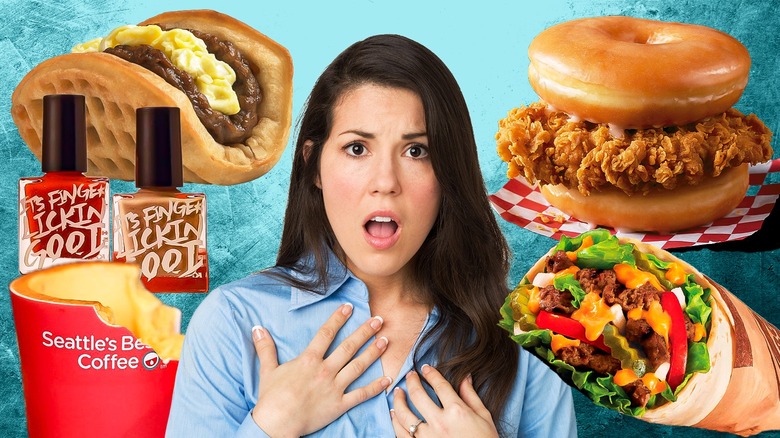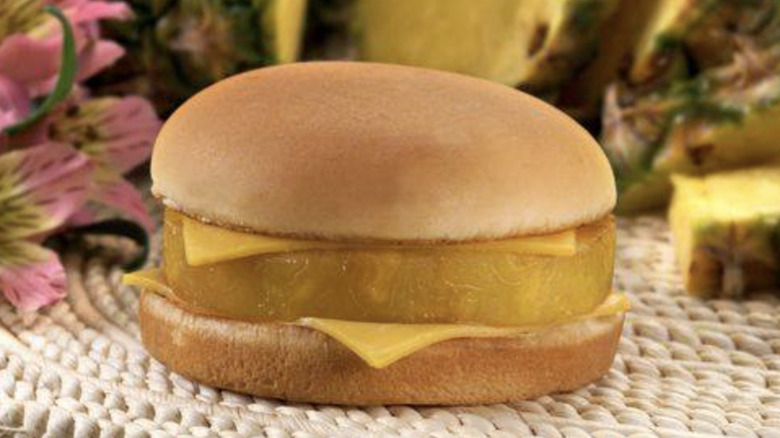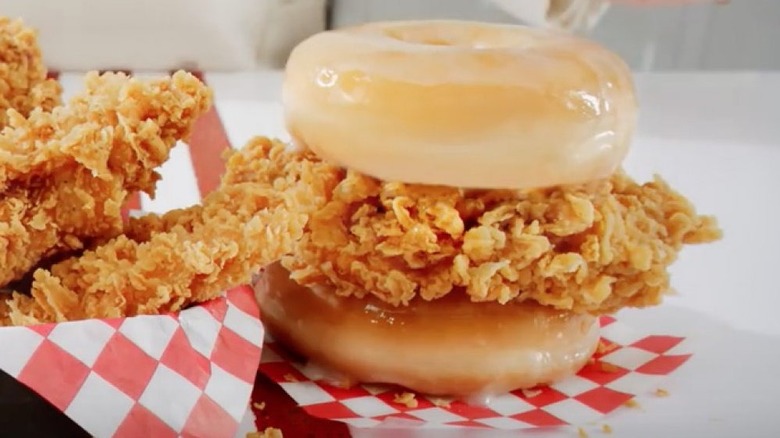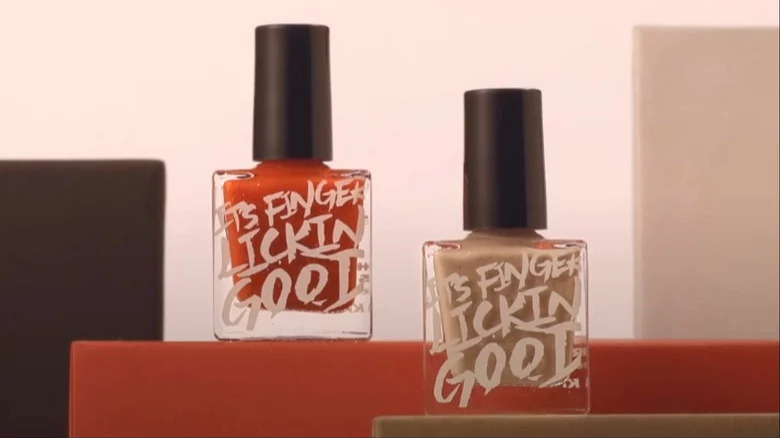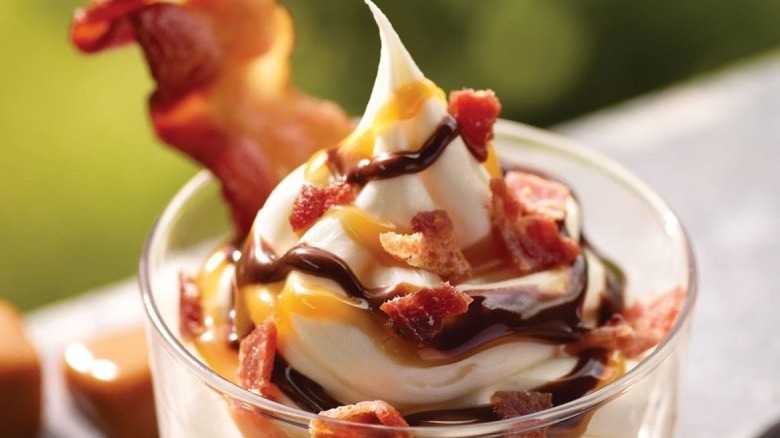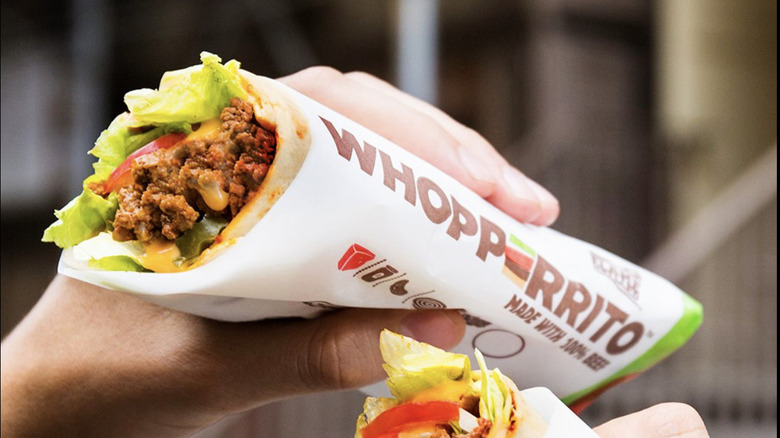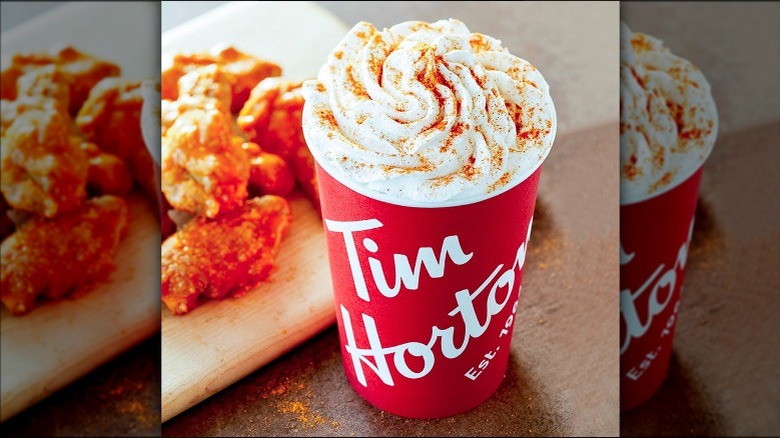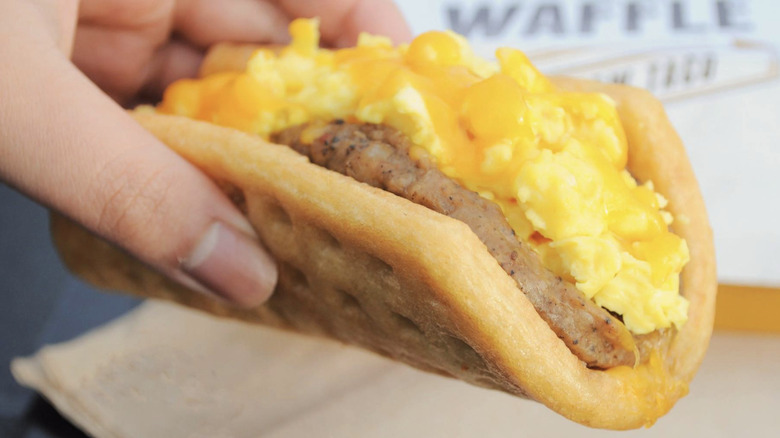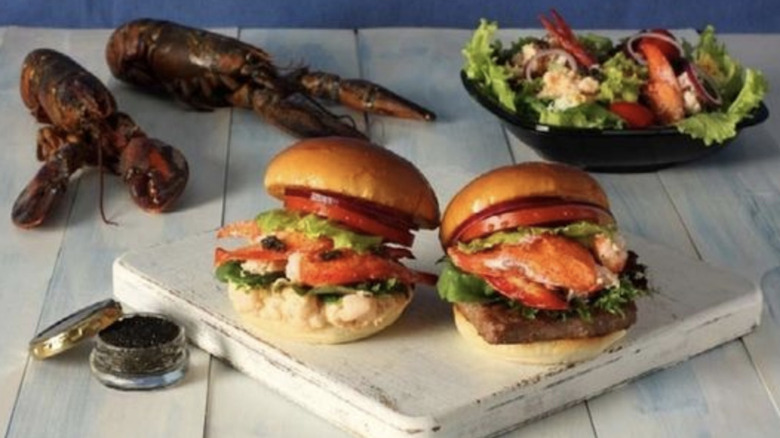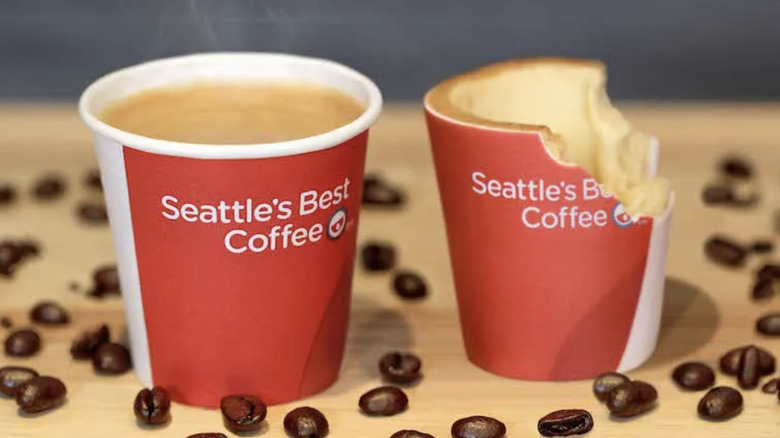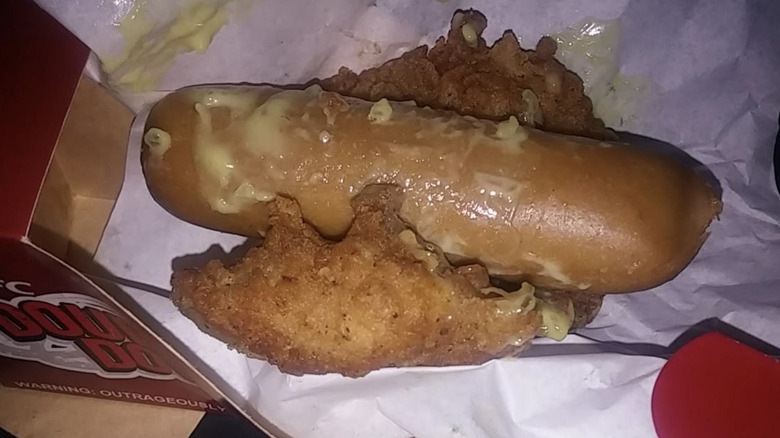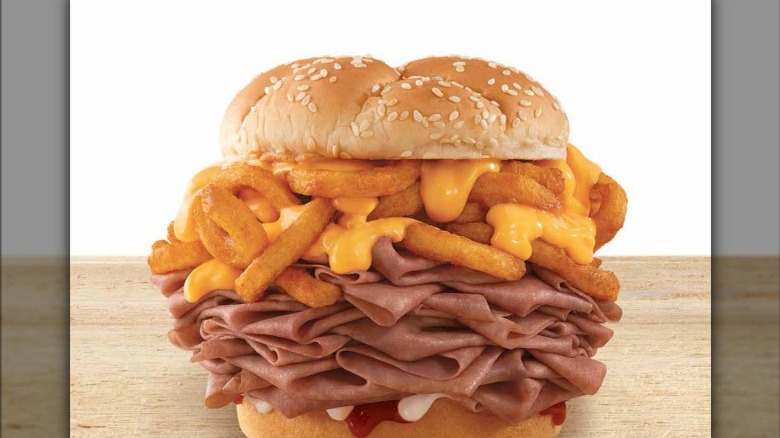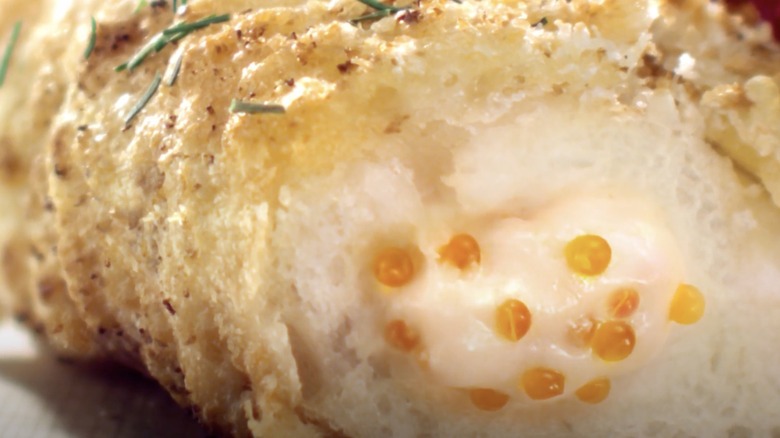Fast Food Menu Items That Took Things Too Far
Fast food has become a prominent fixture on the modern culinary scene, and its popularity continues to soar. Food on the go not only offers convenience but also provides consumers with a comforting sense of familiarity. After all, there's a certain satisfaction in knowing precisely what will be served to you once you place your order.
While every fast food chain has its iconic signature items, such as McDonald's Big Mac and KFC's fried chicken, there are occasions when these establishments like to experiment. And while these innovations let customers break away from their typical menu choices, they can also push the boundaries of customers' palates just a tad too far.
Whether it's an unusual fusion of two contrasting flavors that defy culinary logic or an unexpected amalgamation of ingredients, some fast food experiments resulted in taste experiences that were difficult for customers to embrace. With this in mind, here are some of the strangest fast food items unleashed on the unsuspecting public.
McDonald's Hula Burger
McDonald's Hula Burger epitomizes the culinary world at its simplest and perhaps most peculiar. Conceived by Ray Kroc, who has been credited with transforming McDonald's into the largest fast food empire in the world, the Hula Burger made its debut in the 1960s. The unconventional — and uncomplicated — offering incorporated a bun, cheese, and a grilled pineapple patty.
Perhaps unsurprisingly, the Hula Burger was a huge flop — after all the concept of eating bread, pineapple, and cheese simultaneously doesn't sound all that appealing. Echoing what some of us are no doubt thinking, one Reddit user wrote: "Fried pineapple slices between two pieces of bread is about as sad as a meal gets." So what's the tale of Hula Burger's downfall? To cut a long story short, the burger was discontinued after losing out to McDonald's Filet-O-Fish, which was the other meatless option the company was testing out.
The Hula Burger was intended to boost the chain's sales on Fridays, specifically targeting American Catholics who refrained from eating meat on that day. However, as Kroc was developing his Hula Burger, Lou Groen, a McDonald's franchisee, came up with the Filet-O-Fish. Since the fish burger wasn't what Kroc originally had in mind, he agreed to put both items to the test. Whichever would sell better on a single Friday would be placed on the chain's permanent menu. Since Filet-O-Fish is still on the chain's menu, I think we all know how things turned out.
KFC Chicken & Donuts Sandwich
In 2019, KFC polarized the culinary world with the release of its Chicken & Donuts Sandwich. Consisting of a piece of fried chicken sandwiched between two donuts, the sweet and savory treat sparked a flurry of debates and discussions. As reported by USA Today, the KFC U.S. chief marketing officer, Andrea Zahumensky, emphasized the meticulous attention that had gone into perfecting this fast food marvel, saying, "Only a donut that's glazed-to-order and served piping hot every single time can stand next to our hand-breaded fried chicken."
The reactions to the Chicken & Donuts Sandwich were mixed. Dana Rivera from UPROXX called the casual dining invention a "brutal fast food experience," saying that while the sandwich actually tasted pretty good while you were chewing it, it wasn't long before things took a turn for the worse. And this, she said, had nothing to do with the taste of the meal but the sheer gluttonous spectacle that it represented. "Eat it if you want a fast-food experience that adequately reflects the times we live in," she wrote. "It's a sandwich designed to make you instantly regret eating it, one that makes you feel ashamed for liking it."
KFC edible nail polish
The idea of KFC customers strolling around and licking their fingernails may seem downright peculiar. Not only does it challenge social norms but it also raises legitimate concerns about hygiene. Nevertheless, this didn't stop KFC from throwing caution to the wind with its fried chicken-flavored edible nail polish.
Released in Hong Kong in 2016, the novelty item came in two colors and flavors — the original recipe came in nude and the hot & spicy in burnt orange. However, the hue of the original recipe polish left a lot to be desired and was in fact a swampy, dim, speckled green. And while the polish did taste like KFC's hot & spicy and original recipe seasoning, it had no discernible flavor of fried chicken.
To address any potential concerns regarding the consumption of the "Finger Lickin' Good" offering, KFC made it clear that the product contained natural ingredients. "The recipe for our edible nail polish is unique and was specifically designed to hold the flavor, but to also dry with a glossy coat similar to normal nail polish," added John Koay, creative director for Ogilvy & Mather, a company that worked on the product (via CNN Business). The lack of preservatives in the nail polish, however, meant that it had to be refrigerated and used within five days. The polish was also only suitable for one-time use, which meant that it had to be discarded after opening.
Burger King Bacon Sundae
Unfazed by culinary conventions, in 2012, Burger King took a leap into the great unknown with its Bacon Sundae — a treat that combined contrasting flavors and textures. This menu item consisted of frosty vanilla soft serve served with chocolate fudge, caramel, and "thick hardwood smoked bacon," as reported by HuffPost.
So how did Burger King's Bacon Sundae fare with fast food enthusiasts? The taste tester for HuffPost was impressed with the amount of bacon that went into the dessert, estimating that each sundae contained two or three strips of the stuff. And while the reviewer was quick to point out that they would much rather indulge in a sundae without pork, they also admitted that the dessert's ingredients were complementary. "The saltiness of the bacon was a nice contrast to the sweetness from the rest of the ingredients. I also really liked that the bacon added a crunchy element to the smooth soft-serve," they wrote.
Adam Martin, who wrote about the Bacon Sundae for The Atlantic, described the menu item as the chain's attempt at jumping on the bacon-as-dessert bandwagon that he said had already run its course (the concept of bacon as dessert is said to have kicked off in 2004 with bacon and egg ice cream at the Fat Duck, a three-Michelin-star restaurant in the U.K.). "The product is just such obvious pandering, a clumsy and manipulative stab at trend-chasing," he wrote. "And, honestly, a bacon sundae's not even a good novelty item."
Burger King Whopperito
After more than six decades, the Whopper is still Burger King's signature menu item. First released in 1957, the flame-grilled burger consists of a beef patty, tomatoes, lettuce, onion, and pickles sandwiched between a sesame seed bun. The ensemble is completed with a drizzle of mayo and ketchup. Given the enduring popularity of the Whopper, it's no wonder that devoted fans were taken aback when Burger King introduced a fresh take on the menu item called the Whopperito in 2016. The new addition to the chain's lineup featured the ingredients of a Whopper wrapped burrito-style. Aside from the addition of the tortilla, the Whopperito featured queso sauce rather than the mayo and ketchup typically used in the Whopper.
The Whopperito definitely didn't go unnoticed, but reactions to the item were decidedly mixed. While the novel concept was shunned by some, others were sold. Fox News reported that while the idea of pickles in a tortilla was somewhat unusual, a number of taste testers were genuinely pleased with the Tex-Mex offering. One fast food enthusiast said, "[it's a] weird concept but I like it," while another enthusiastically declared, "I like that it's in a wrap. It's cute. It's handheld."
Tim Hortons Buffalo Latte
While Buffalo sauce is usually associated with chicken wings, its zesty and spicy flavor also makes a welcome addition to other dishes such as tacos and potato skins. However, there are certain menu items where Buffalo sauce seems out of place. One such offering was Tim Hortons' Buffalo Latte, which made its debut on the fast food scene in 2017. Crafted with espresso, chocolate, and buffalo sauce, and finished off with whipped topping and Buffalo seasoning, the beverage was available in select Tim Hortons outlets in Buffalo, New York.
Tim Hortons introduced the Buffalo Latte as a limited-time item to showcase the chain's new lineup of espresso, featuring lattes, cappuccinos, and Americanos, as well as a range of new flavors such as vanilla, mocha, caramel, and pumpkin spice. As such, it's probably not surprising that the chain's U.S. regional president, Stephen Goldstein, offered an offbeat rationale for introducing the unusual item, saying, "Tim Hortons and Buffalo sauce were both born in 1964, so why not take these two Buffalo staples and combine them?" (via Myrecipes).
Taco Bell Waffle Taco
Recognizing that waffles and tacos are both fantastic, one fast food chain decided to unite them, creating a one-of-a-kind fusion that was supposed to satisfy two diverse cravings in a single culinary creation. Taco Bell's Waffle Taco — which was made up of a waffle folded over a sausage patty or bacon, scrambled eggs, and cheese — was released as a part of the franchise's breakfast menu in 2014. The questionable offering was accompanied by syrup that could be poured over the novelty item to enhance its sweetness.
Taco Bell experimented with 80 renditions of the dish before deciding on the final version. Despite the chain's efforts, the Waffle Taco failed to resonate with consumers and was discontinued within a year of its release. One dissatisfied Taco Bell customer complained about the novelty breakfast item in a Facebook post, saying, "This looks disgusting. The eggs don't even look the least bit good even in a picture or real for that matter. [...] Just stick to regular burritos nachos and tacos please!"
Realizing its mistake, in 2022, the fast food giant went as far as hiring the comedian and actor Pete Davidson to apologize on behalf of the chain for its past breakfast blunders. "Taco Bell went a bit crazy with breakfast. It was too much. What you need in the morning is tasty, simple food," Davidson said in an advertisement. This was a dig at past items such as the Waffle Taco and the Naked Egg Taco.
Wendy's caviar and lobster selection
The rich flavor of caviar and the succulent, buttery taste of lobster are typically associated with opulence and fine dining. This is why many were left confused when, in 2012, Wendy's launched its lobster and caviar offerings at outlets in Japan. Shellfish enthusiasts were able to select from the Premium Caviar & Lobster Sandwich and the Lobster Surf & Turf Burger, which were made with Canadian Omar lobsters. And for the health-conscious, Wendy's offered the Ocean Premium Salad with lobster, avocado, onion, and egg. In case you're curious about the prices, the burger and sandwich were $16 each while the salad cost $20 a pop. This is the equivalent of around $21 and $26 today — a little pricey for casual dining.
The limited-time offerings were just some of Wendy's other upscale meal ideas launched in Japan to celebrate the chain's re-entry into the country's market after a two-year hiatus. Some of these extravagant items included the foie gras and truffle mushroom burger and the truffle and porcini grilled chicken sandwich. To explain the move, the chief executive officer of Wendy's Japan LLC, Ernest Higa, commented: "The Japanese consumer, as compared to the U.S., they want higher quality, higher service, generally speaking, and they also want variety [...] It's an affluent economy and a very sophisticated consumer" (via AOL).
KFC edible coffee cup
Combining the convenience of a disposable cup with a sustainable twist, KFC's edible coffee cup was as strange as it was ingenious. Introduced at the chain's UK outlets in 2015, the limited edition Scoff-ee Cup was made from a hard biscuit that resembled a wafer. To add taste and ensure that the cup maintained its structural integrity during use, it was also lined with sugar paper and a protective heat-resistant white chocolate coating. The edible cup was released to celebrate the release of Seattle's Best Coffee at the chain's outlets in the U.K.
As if the unique composition of the biscuit cup wasn't enough, the edible vessels were also imbued with scents such as wildflowers, freshly cut grass, and coconut sun cream. A spokesperson for The Robin Collective, a group of food scientists who masterminded the cups, explained the logic behind the design, saying, "These scents were used in our recipes as they have a natural ability to evoke the positive memories we associate with warm weather, sunshine and summer holidays. Things that make everyone smile," as reported by People.
KFC Double Down Dog
KFC's Double Down Dog was a spruced up — and more offbeat — version of the Double Down, a sandwich made with bacon and cheese lodged between two filets of fried chicken that made its debut in the U.S. in 2010. Released in the Philippines in 2015, the Double Down Dog consisted of a hot dog-style frankfurter sausage encased in two fried chicken filets. And just like a real hot dog, the gluttonous menu item came with optional mayo, ketchup, and cheese.
Cedric Lizotte reviewed the off-beat treat for Continents Condiments, and let's just say that he wasn't impressed. Lizotte proclaims that he was underwhelmed by the item's small size and aesthetics, saying that it was "the saddest-looking chicken sandwich [he'd] ever laid eyes on." According to the brave taste tester, the sandwich was also unimpressive in terms of flavor. "The chicken was extremely salty and oily," he writes, adding that the meal came with a "greasy processed orange cheese."
Arby's Arbynator
What made Arby's Arbynator stand out from the fast food pack was its ridiculous size. Coming in at half a pound, the giant sandwich consisted of sliced roast beef, curly fries, and three different sauces — Arby's sauce, Horsey sauce, and cheddar sauce. For those who found the menu item too hard to swallow, the chain also offered smaller versions of the casual snack including the classic and the double. Perhaps sensing the over-the-top nature of its behemoth creation, the chain served the Arbynator only for a limited time in 2018.
According to Brand Eating, while the Arbynator's three sauces offered a nice balance of tangy, sweet, and creamy flavors and textures, the sandwich was pretty messy to eat. The reviewer for the platform also commented that the addition of the seasoned curly fries provided an extra layer of flavor and crunch to the overall experience.
Commenting on the Arbynator's size, Louis from TheImpulsiveBuy, who tried the classic version of the sandwich, said that even the smallest option had way too much meat. "There's no way an Average Joe will down the Arbynator during his lunch hour, head back to the office, and not put his head down for a long winter's nap. It's too darn much," he wrote.
Pizza Hut's Flying Fish Roe Salmon Cream Cheese Pizza
In recent years, we've witnessed some peculiar experiments with pizza crust. Pizza Hut's Flying Fish Roe Salmon Cream Cheese Pizza is a case in point. Introduced in Hong Kong in 2014, as its name suggests, the pie came with a crust stuffing made from fish eggs and salmon-flavored cream cheese. The pizza came in two different toppings. For seafood enthusiasts, the Crayfish Seafood Deluxe Pizza featured crayfish, clams, scallops, shrimp, and a bunch of the typical veggies you usually find on a Pizza Hut offering. Alternatively, carnivores could indulge in the chain's Sausage, Pepperoni & Pomelo Pizza, which combines all that its name suggests plus berry sauce, peaches, and more.
This isn't the first time Pizza Hut has outdone itself in the unusual pizza crust department. In 2012, Pizza Hut Middle East released the Crown Crust Pizza, which let pizza enthusiasts choose between a crust filled with either cheeseburgers or chicken filets. Two years later, the fast food giant introduced its Chee-Zee Marmite Stuffed Crust Pizza in New Zealand. Just like its name suggests, the pie was filled with cheese and the polarizing yeast spread.
